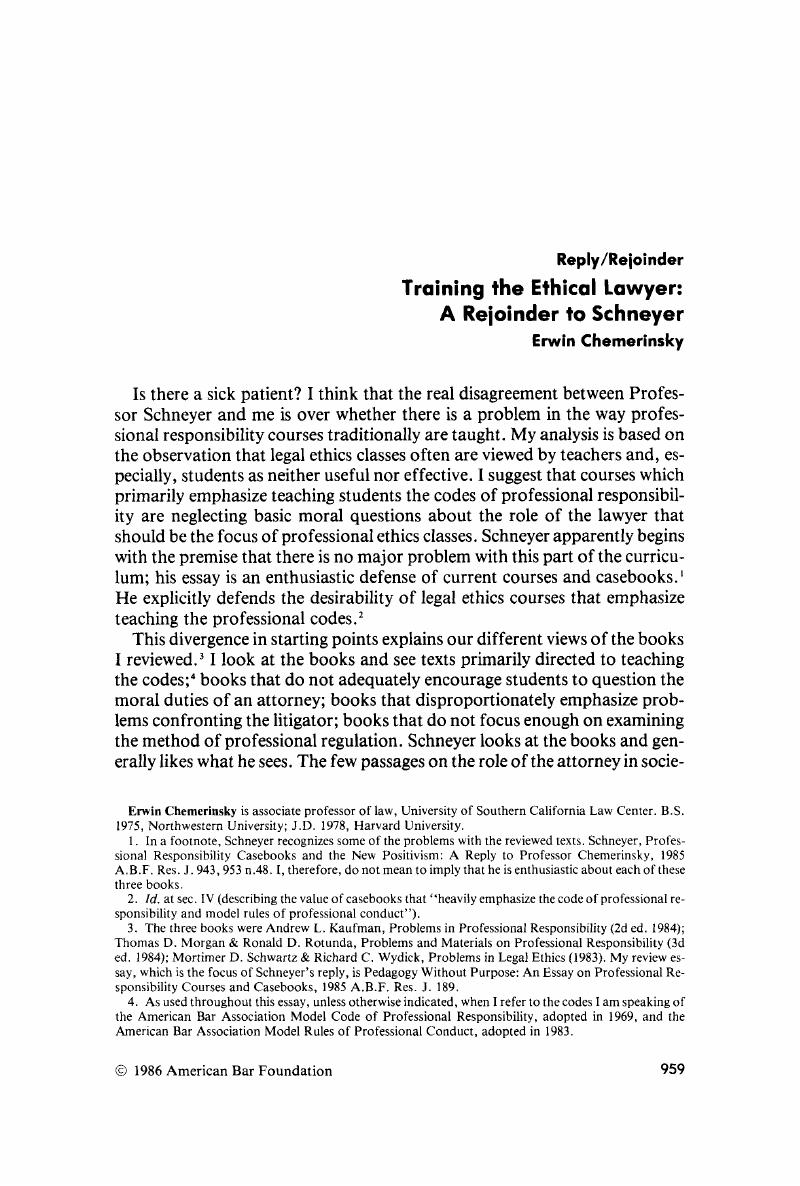No CrossRef data available.
Published online by Cambridge University Press: 20 November 2018

1 In a footnote, Schneyer recognizes some of the problems with the reviewed texts. Schneyer, Professional Responsibility Casebooks and the New Positivism: A Reply to Professor Chemerinsky, 1985 A.B.F. Res. J. 943, 953 n. 48. I, therefore, do not mean to imply that he is enthusiastic about each of these three books.Google Scholar
2 Id. at sec. IV (describing the value of casebooks that “heavily emphasize the code of professional responsibility and model rules of professional conduct”).Google Scholar
3 The three books were Andrew L. Kaufman, Problems in Professional Responsibility (2d ed. 1984); Thomas D. Morgan & Ronald D. Rotunda, Problems and Materials on Professional Responsibility (3d ed. 1984); Mortimer D. Schwartz & Richard C. Wydick, Problems in Legal Ethics (1983). My review essay, which is the focus of Schneyer's reply, is Pedagogy Without Purpose: An Essay on Professional Responsibility Courses and Casebooks, 1985 A.B.F. Res. J. 189.Google Scholar
4 As used throughout this essay, unless otherwise indicated, when I refer to the codes I am speaking of the American Bar Association Model Code of Professional Responsibility, adopted in 1969, and the American Bar Association Model Rules of Professional Conduct, adopted in 1983.Google Scholar
5 I will discuss this further infra part II of the text.Google Scholar
6 Although the model code does not contain provisions specifically dealing with the attorney as negotiator, the model rules have several sections pertinent to this topic. See Model Rules of Professional Conduct Rule 3.4 (fairness to opposing party and counsel); 4.1 (truthfulness in statements to others).Google Scholar
7 The only provision in the model code directly dealing with attorneys representing entities such as corporations is EC 5–18. Model rule 1.13 covers the “organization as client.”.Google Scholar
8 Model rule 1.2(a) concerns the allocation of decision-making authority and its comment recognizes that it “has no counterpart in the Disciplinary Rules of the Model Code.” Model code EC 7–8 does discuss allocation of decision making.Google Scholar
9 For example, concerning delay, the code simply says that an attorney “shall not … delay a trial when it is obvious that such action would serve merely to harass or maliciously injure another.” DR 7–102(A)(1). For a discussion of the inadequacy of the code, see Edelstein, The Ethics of Dilatory Motion Practice: Time for a Change, 44 Fordham L. Rev. 1066 (1976).Google Scholar
10 The model code says that attorneys shall not “[k]nowingly use perjured testimony.” DR 7–102(A)(4). However, the code also requires attorneys to protect client confidences, DR 4–101, and offers no guidance for how to resolve this conflict. See Nix v. Whiteside, 106 S. Ct. 988 (1986) (attorney's threat to disclose client perjury is not ineffective assistance of counsel).Google Scholar
11 Of course, there is no inherent reason why a course emphasizing the code could not also consider problems outside the code. My point is that it is not the content of the codes but the problems confronting attorneys that should determine the coverage of the course. Moreover, if the focus of the course is on the codes, it is all too easy to give short shrift to matters not dealt with in the rules.Google Scholar
12 Schneyer, supra note 1, at 954.Google Scholar
13 Id. at 955.Google Scholar
14 See Model Code of Professional Responsibility DR 2–110(C) (permissive withdrawal); DR 4–101(C) (describing confidences that a lawyer may reveal).Google Scholar
15 Neither the model code nor the model rules contain any exception permitting attorneys to disclose confidential information about a client's past crimes. Model Code of Professional Responsibility DR 4–101(C); Model Rules of Professional Conduct Rule 1.6. Therefore, e.g., if an attorney learned that a client had framed an innocent person who was going to be put to death for the client's crime, the attorney would violate the codes by disclosing the client's responsibility for the crime to save the innocent person.Google Scholar
16 Schneyer, supra note 1, at 955.Google Scholar
17 See, e.g., Model Code of Professional Responsibility Canon 7 (a lawyer should represent a client zealously within the bounds of the law).”.Google Scholar
18 See, e.g., People v. Belge, 372 N.Y.S.2d 798 (1975) (attorney acted properly in not revealing location of victims' bodies at the bottom of a mine shaft).Google Scholar
19 Schneyer, supra note 1, at 956.Google Scholar
20 This is discussed more fully in my review, supra note 3, at 192–94.Google Scholar
21 Schneyer, supra note 1, at 956.Google Scholar
22 Id.Google Scholar
23 Id.Google Scholar
24 Id. at 957.Google Scholar
25 Id.Google Scholar
26 Id.Google Scholar
27 See id. at 956.Google Scholar
28 Id. at 958.Google Scholar
29 Id. at 946.Google Scholar
30 Id.; Morgan & Rotunda, supra note 3, at 128–36.Google Scholar
31 The material is in chapter 4 (“Ethical Problems in General Litigation”), at 128–36, in a book of nine chapters and 471 pages.Google Scholar
32 Schneyer, supra note 1, at 946.Google Scholar
33 Morgan & Rotunda, supra note 3, at 62–65.Google Scholar
34 Schneyer, supra note 1, at 945; Schwartz & Wydick, supra note 3, at 1.Google Scholar
35 Schneyer, supra note 1, at 949.Google Scholar
36 Schwartz & Wydick, supra note 3, at 1–3.Google Scholar
37 Chemerinsky, supra note 3, at 195.Google Scholar
38 Schneyer, supra note 1, at 949.Google Scholar
39 Morgan & Rotunda, supra note 3, at 142–44 (some of the notes on these pages deal with trial tactics, not negotiating tactics, e.g., at 144 n.4). There is a problem concerning negotiating a guilty plea in a later chapter on issues in criminal law practice. Id. at 224.Google Scholar
40 Schneyer, supra note 1, at 951.Google Scholar
41 Id.Google Scholar
42 Id. at 943.Google Scholar
43 Id. at sec. III.Google Scholar
44 Chemerinsky, supra note 3, at 185 n.17.Google Scholar
45 Id. at 198.Google Scholar
46 Id. at 199.Google Scholar